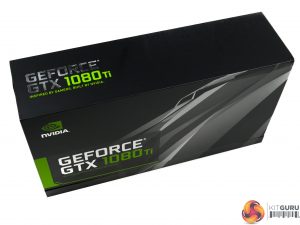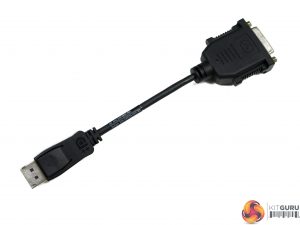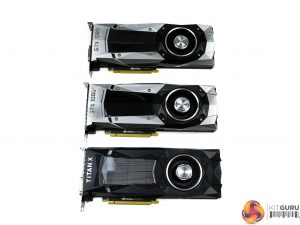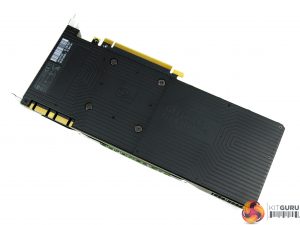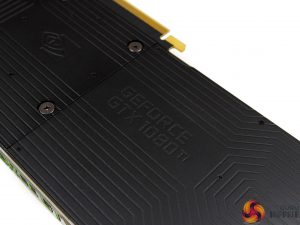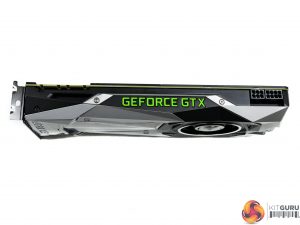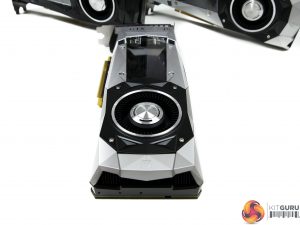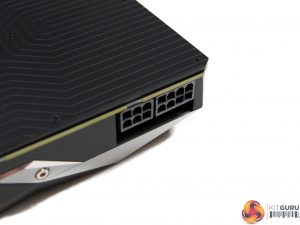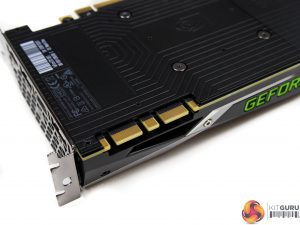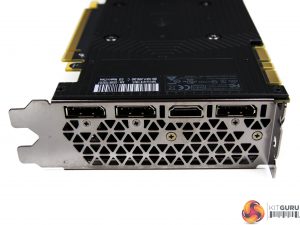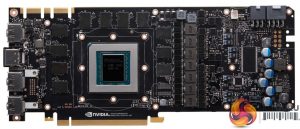Our GTX 1080 Ti Founder's Edition sample shipped directly from Nvidia in a box that has become synonymous with the Pascal FE cards.
Nvidia supplies a DisplayPort-to-DVI (dual-link DVI-D) adapter due to the GTX 1080 Ti's slight redesign on the rear IO. DVI has been dropped and is now supported via the supplied DP-to-DVI adapter or by converting the onboard HDMI 2.0 connection.
The Founder's Edition cooler used on the GTX 1080 Ti features similarities to that found on the GTX 1080. A die-cast aluminium body houses the cooling system that comprises a copper vapour chamber in contact with the GPU, an aluminium fin array, and a radial fan that forces air towards the rear vent.
Measuring 10.5″ in length, standard width for a PCIe expansion card, and conforming to a dual-slot form factor, compatibility is key to the Founder's Edition design logic. Nvidia has created a card that can be installed inside a variety of systems, from a standard ATX-sized chassis to a mini-ITX build with limited cooling space and case airflow.
The rear-exhaust cooling method, as opposed to internally-venting coolers found on many after-market cards, is designed to dump a significant proportion of the heat outside of the chassis thus reducing the requirement for strong case airflow to maintain suitable operation.
Backplate design follows the same two-plate split methodology applied for the GTX 1080 Founder's Edition and Titan X Pascal cards. Two thin metal backplates connect separately to the rear PCB allowing them to be removed individually. This has the benefit of allowing the single backplate piece residing behind the radial fan to be removed to create a small cooling gap if a pair of GTX 1080 Ti cards is installed back-to-back in SLI.
Other than a more aesthetically-pleasing appearance than a bare PCB, backplates on GPUs are able to aid structural rigidity of the card. They can also passively transfer heat away from the PCB, if designed correctly.
Silver, black, and a hint of green is the go-to style for Nvidia's Founder's Edition cards and the GTX 1080 Ti continues that trend. The side-mounted ‘GEFORCE GTX‘ logo is coloured green and features an LED that can be controlled via software, though not with particularly advanced functionality or RGB options.
The angled design of Nvidia's new cooler it introduced with Pascal cards seems to have been well received by enthusiasts who like the styling and largely two-tone appearance.
Tipping the scales at just over 1kg, much of which can be attributed to the cooler, it is easy to understand the challenge of designing a 250W-capable cooling system with such limited volumetric (not to mention cost) constraints. The GTX 1080 Ti FE weighs the same as both the Titan XP and the GTX 1080 FE, despite the latter using a lower speed fan (which could be software limited).
Nvidia's marketing material is claiming 2x the airflow area over the GTX 1080 for the GTX 1080 Ti Founder's Edition cooler. However, this basically seems to be an interpretation of the rear IO venting space gained by removing the DVI port. So don't be misled by claims of 2x the airflow area as it doesn't directly translate into real world performance. That's especially true for fluids such as air that can simply undergo a change in flow velocity to be forced through smaller cooling gaps meaning that area isn't the only metric of importance.
Power is delivered to the GTX 1080 Ti through a combination of side-mounted 8-pin and a 6-pin PCIe power connectors. We expect to see board partners shipping factory-overclocked cards that leverage dual 8-pin PCIe power connectors, or perhaps even a trio for overclocking-geared SKUs.
TDP, which isn't technically power draw but serves as a rough estimation, sits at 250W and Nvidia recommends pairing GTX 1080 Ti with a 600W PSU.
A pair of gold fingers provide SLI support for the GTX 1080 Ti. If you have deep pockets and high graphical demands in your games, coupling together a pair of GTX 1080 Ti graphics card will require the use of a high-bandwidth SLI bridge for the highest level of performance.
More information relating to Nvidia's approach to SLI with Pascal can be found HERE.
Here comes one of the biggest changes for Nvidia's GTX 1080 Ti graphics card – the rear IO. Nvidia opts for a combination of triple DisplayPort 1.4-ready connections and an HDMI 2.0b output. The DVI port has been dropped, meaning that you'll have to rely upon an HDMI to DVI or DisplayPort to DVI (included) adapter. The decision to drop DVI is driven by the real estate it commands on the rear IO backplate and Nvidia's thoughts that the space is better allocated to additional cooling ventilation.
As a triple-monitor user for my workstation PC, I am sad to see DVI being dropped. However, I completely understand the decision and like that Nvidia includes an adapter for users with older monitors that don't support HDMI 2.0 and who don't want the Windows headaches introduced by DisplayPort. Expect board partner cards to restore the DVI output. It's also likely that some vendors will switch out one of those DisplayPort connectors in favour of an additional HDMI port that's more convenient for VR users.
One of the main positives I see from switching to a single row of display outputs is liquid cooling support. The possibility for single-slot liquid-cooled cards has returned and it doesn't involve chopping off one's DVI port on a £699 graphic card!
Eleven GDDR5X memory chips comprise the 11GB of VRAM. Nvidia has enhanced the power delivery system compared to the GTX 1080 Founder's Edition. A 7-phase control system drives a total of 14 dual-FETs with a rated power capacity of 250 Amps for the GPU.
This is an upgrade from the GTX 1080 both in terms of control channels and FET count, as the GTX 1080 Ti now uses two dual FETs per control channel, as opposed to one. It is also an upgrade from the Titan X Pascal's power delivery solution which is likely to translate into slightly higher electrical efficiency or better overclocking.
Be sure to check out our sponsors store EKWB here
 KitGuru KitGuru.net – Tech News | Hardware News | Hardware Reviews | IOS | Mobile | Gaming | Graphics Cards
KitGuru KitGuru.net – Tech News | Hardware News | Hardware Reviews | IOS | Mobile | Gaming | Graphics Cards


